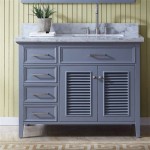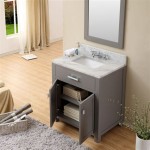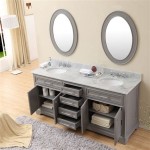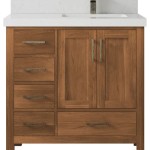Standard Sizes of Bathroom Vanities: A Comprehensive Guide
Bathroom vanities are a crucial element of bathroom design, providing both storage and a focal point for the space. Selecting the correct size vanity is essential for functionality, aesthetics, and overall bathroom flow. Understanding standard vanity sizes helps homeowners and design professionals make informed decisions during renovation or new construction projects. This article explores typical dimensions, measurements, and considerations related to bathroom vanity sizes.
Standardization in vanity sizes aims to offer a balance between accommodating common plumbing configurations, providing adequate countertop space, and fitting comfortably within typical bathroom layouts. While custom vanities offer nearly limitless possibilities, standard sizes provide a more cost-effective and readily available option. Knowing the ranges within which standard vanities fall simplifies the selection process.
Height of Bathroom Vanities
The height of a bathroom vanity significantly impacts user comfort, especially for individuals of varying heights. Over time, standard vanity heights have evolved in response to changing ergonomic preferences.
Traditionally, bathroom vanities were typically 30 to 32 inches tall. This height was considered standard for many years. However, the older standard can often result in bending or stooping, which can be uncomfortable, especially when performing daily tasks like washing hands or brushing teeth. This height might still be suitable for children's bathrooms or bathrooms designed with a vintage aesthetic.
The modern standard for bathroom vanity height is between 34 and 36 inches. This taller height, often referred to as "comfort height," is designed to reduce strain on the back and neck. While a difference of only a few inches may seem minor, the improved ergonomics are noticeable over time. Many manufacturers now primarily produce vanities within this comfort height range.
The decision between the traditional and modern height depends on the users of the bathroom. In households with taller individuals, the comfort height will likely be preferred. Conversely, if the bathroom is primarily used by children, a shorter vanity might be more appropriate. It's also possible to install a platform or step stool to assist children in reaching a taller vanity.
When selecting a vanity height, consider the height of the sink. The sink basin's depth can influence the overall functional height of the vanity. A deeper sink might effectively lower the usable surface height, whereas a shallow sink will maintain the intended height.
Width of Bathroom Vanities
Vanity width dictates the amount of countertop space and storage available. Standard vanity widths vary widely to accommodate different bathroom sizes and configurations. Measuring the available space accurately is crucial before selecting a vanity width.
Smaller bathrooms often utilize vanities with widths ranging from 24 to 36 inches. These compact vanities are suitable for powder rooms or bathrooms with limited floor space. Despite their smaller size, these vanities can still offer sufficient storage with cabinets or drawers beneath the sink.
Mid-size bathrooms typically accommodate vanities with widths between 48 and 60 inches. This range provides a balance between countertop space and storage capacity. Vanities in this size range are often equipped with multiple drawers and cabinets, offering ample storage for toiletries and other bathroom essentials.
Larger bathrooms can accommodate vanities with widths of 72 inches or more. These larger vanities often feature double sinks, providing separate washing areas for multiple users. Vanities of this size offer extensive countertop space and abundant storage options, making them ideal for master bathrooms or shared bathrooms.
It is essential to consider the placement of other bathroom fixtures, such as toilets and showers, when determining the appropriate vanity width. Ensure sufficient clearance around the vanity for comfortable movement and access to other fixtures. Building codes often specify minimum clearances between fixtures.
Floating vanities, which are mounted to the wall without legs, are available in various widths. These vanities can create a more open and spacious feel in the bathroom. However, the wall must be adequately reinforced to support the weight of the vanity and its contents.
Depth of Bathroom Vanities
Vanity depth refers to the distance from the front of the vanity to the wall. Standard vanity depths generally range from 18 to 24 inches.
A standard depth of 21 inches is commonly found. This depth provides sufficient countertop space while minimizing the amount of floor space occupied by the vanity. This depth is often suitable for smaller bathrooms where space is a premium.
Shallower vanities, with depths of 18 inches or less, are available for very small bathrooms or powder rooms. These vanities sacrifice countertop space in favor of maximizing floor space. Wall-mounted faucets are often used with shallow vanities to further conserve space.
Deeper vanities, with depths of 24 inches or more, offer more countertop space and storage capacity. These vanities are often preferred in larger bathrooms where space is not a concern. However, it is important to ensure that the deeper vanity does not obstruct walkways or interfere with the use of other bathroom fixtures.
The choice of sink can also influence the required vanity depth. Vessel sinks, which sit on top of the countertop, may require a slightly shallower vanity depth compared to undermount sinks. The faucet placement also is impacted by sink choice. A vessel sink needs a taller faucet to reach over the basin.
Consider the door swing of the vanity cabinet when determining the appropriate depth. Ensure that the doors can open fully without hitting other fixtures or walls. Soft-close hinges can help prevent damage to the vanity and surrounding surfaces.
Corner vanities are designed to fit into the corner of the bathroom, maximizing space utilization. These vanities typically have a depth of around 24 inches on each side.
Freestanding vanities, which are not attached to the wall, may have different depth dimensions compared to standard vanities. These vanities offer a more furniture-like aesthetic and can be positioned in various locations within the bathroom.
When replacing an existing vanity, it is essential to measure the depth of the old vanity to ensure that the new vanity will fit properly within the available space. Check the location of the plumbing connections to ensure compatibility with the new vanity.
Ultimately, the selection of the size and style of bathroom vanities will depend on the needs and preferences of the homeowner.

What Is The Standard Height Of A Bathroom Vanity

What Is The Standard Bathroom Vanity Height Size Guide

What Are Standard Bathroom Vanity Sizes And Size Do I Need Wide Canvas

Bathroom Vanity Cabinet Dimensions Essential Guide 2025

Mirror Size For 24 Vanity

What Is The Standard Bathroom Vanity Height Size Guide

Standard Bathroom Vanity Size Dimensions Is

Vanity Cabinet Depth Complete Guide For Contractors Brands 2025

Twh Vs30 Torrance White 30 Vanity Sink Base Double Door Drawer Front Cabinetselect Com

Dhp Sunnybrooke 36 Inch Bathroom Vanity With Sink White Wal Com







